Final Report for FNC15-1002
Project Information
Website: bearstreetranchllc.wordpress.com
- Project Duration: Grazing seasons 2015 and 2016, an ongoing project
- Date of Report: 2017
PROJECT BACKGROUND
Bear Street Ranch, LLC is 78.5 acres (added 5 acres in 2016) in central Minnesota. It consists of 38 acres of hardwood forest, 27 acres of pasture, 12.5 acres of grass hay. The property has several temporary and permanent ponds and a half mile of river frontage. We produce lamb, chickens, eggs and hay. We use multi-species intensive grazing methods to provide quality forage to our small flock (24) of grass-fed hair sheep ewes and two horses. We lamb each spring and feed our ewes our own all natural hay in the winter.
I have been practicing intensive rotational grazing with horses on this farm since 2003 and before that since 1979.
I added sheep and hogs to remove buckthorn as a part of a research project with a SARE grant in 2010-2012 as #FNC10-838.
Hair sheep of Dorper, Katahdin and St. Croix breeds were chosen because they are easy to care for, and require no de-horning, tail docking or shearing and rarely need help with lambing. They can fatten on grass alone, unlike many commercial wool breeds.
GOALS
- Stop the degradation of the forests by buckthorn infestation.
- Improve pastures by removing prickly ash thickets and buckthorn.
- Target Reed Canary grass on riparian areas.
- Avoid using herbicide.
- Prevent predation (mainly dogs, coyotes).
- Trap and kill biting flies to allow more grazing and better animal comfort during daylight hours.
- Limit production of filth flies in livestock paddocks and barns.
- Control internal parasites in horses and sheep by inter-species rotational grazing.
- Protect sensitive wetlands from erosion and run-off into surface water.
- Protect ground water.
- Raise quality lamb.
PROCESS
The sheep were moved onto pastures with no water, electricity or shelters. Though most of the pastures had access to river water, we provided fresh water in water tanks using a four-wheeler and water wagon.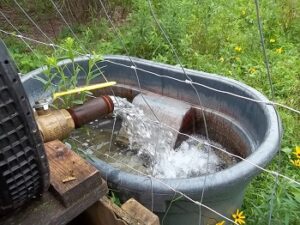
We established permanent perimeter fences by attaching woven wire “field fence” onto existing barbed wire fence, and added a permanent paddock out of cattle panels and T-posts to provide a safe paddock.
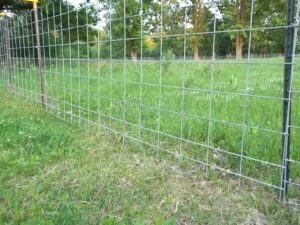
.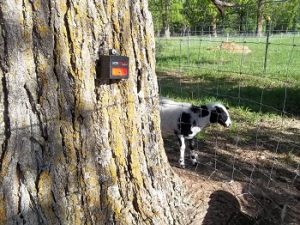
The paddock was surrounded by Nite-Guard Solar predator lights.
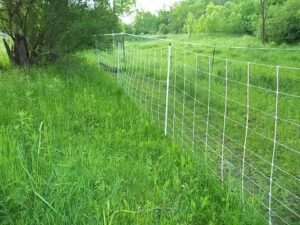
The pastures were split into smaller sections using electro-web electric fences.We experimented with pasture sizes to accommodate 42 sheep over about 3-5 days. The electro-web fences were powered by a Zareba fencer that could be powered with 4 D-Cell batteries which is plenty for hogs and horses, but sheep won’t get shocked unless they have strong ground contact (better when the soil is wet) and the fences are more effective when the sheep have thinner coats in the summer. As the fall weather dries the soil and the sheep grow thick undercoats for winter, they won’t feel the shock with a weak fencer. We chose a more powerful 12-volt deep cycle battery and kept it charged all summer with a 12-volt solar charger. (There was no electricity available.)
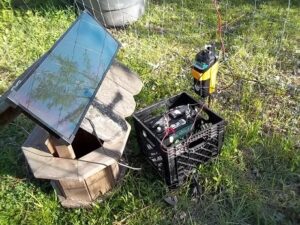
The Zareba fencer mounts on its own ground rod and is very portable.
The 14 ewes and 28 lambs grazed the south end of the river starting May 15 2015. The horses grazed the north pastures. By grazing multi-species using rotational grazing in alternate years, we hope to break the life cycle of internal parasites and reduce the need for wormer by using fecal samples.
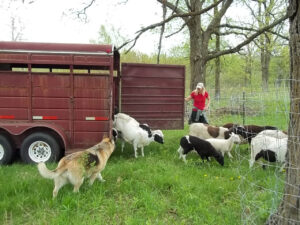
The horses were used to target reed canary grass as early as possible. It is the first grass to green up in the spring. We hoped to impact the reed canary grass without harming the early wildflower bloom of Trillium, Spring Beauties and Trout Lilies. (Horses don’t graze these early wildflowers, whereas sheep d0.) By grazing the reed canary grass early, we prevented it from out-growing native species and forming a thick mat.
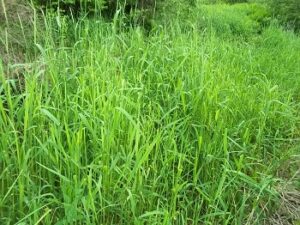
Sheep and horses are top down grazers. They graze off the tops of the grasses first, then return later to graze the rest. An exclosure shows the impact of grazing animals compared to un-grazed mats.
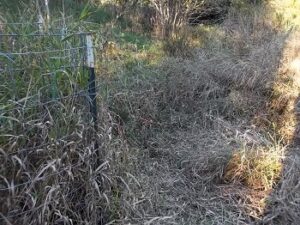
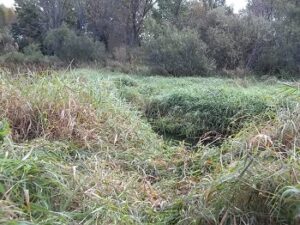
Reed canary grass has out-competed with native grasses and created this thick grass mat on both sides of the river. Reed canary grass has shallow roots compared to native species which allows more erosion and siltation during floods. Spring flooding caused the early young reed canary grass to be covered in silt. It was unpalatable and inaccessible until well into the grazing season.
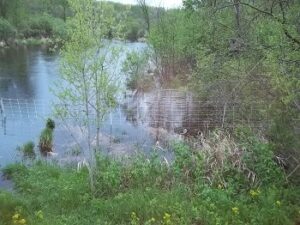
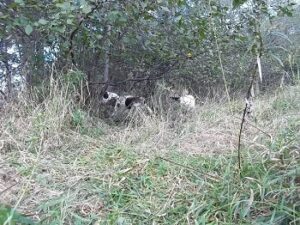
Sheep graze and trample thick reed canary mats.
Originally, I planned to cut the Buckthorn and Prickly Ash thickets using a Stihl brush cutter but the canopies were such a tangled mess that it was easier to use a brush lopper to remove a little at a time. 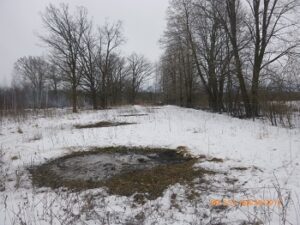
Brush from tops were burned to create more pasture in the spring of 2015.
Once I started dropping trees, the sheep learned to come and browse off the leaves and created a nutritious daily treat.
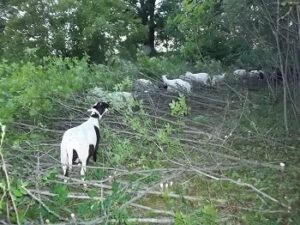
Once the brush was cut and grazed the sheep were removed until the stumps had sprouted leaves.
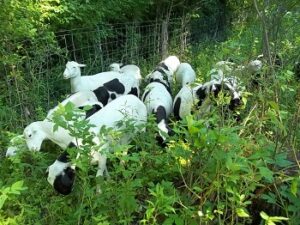
The sheep re-grazed the new growth until all vegetation was removed again. This was repeated throughout the season.
Four “exclosure” areas were fenced off to compare to grazed areas. We set up three 16 X 16 (using cattle panels to make square pens in Buckthorn and Prickly Ash thickets.) We used these “exclosures” for comparison over grazed areas. We also set aside two 4 X 4, exclosures in pastures. Pictures show the difference between the grazed and un-grazed areas.
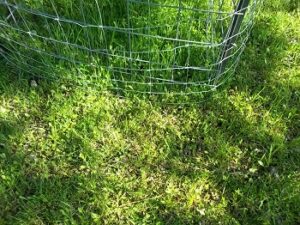
Grazed and ungrazed areas.
SHELTERS:
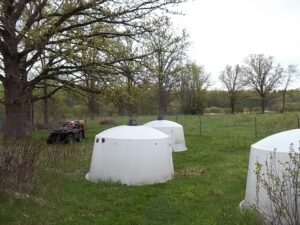
We provided five poly-dome calf shelters and
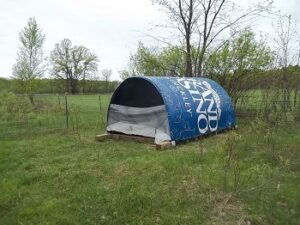
a hoop house shelter made of cattle panels and a billboard tarp, and built on skids.
The sheep used the shelters during biting fly season and during cold rains. The barns were designed to catch biting flies and prevent the growth of filth flies.
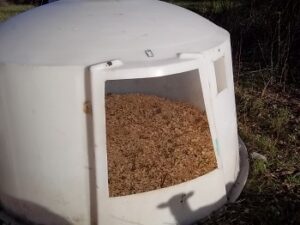
Each poly-dome had two inches of sawdust to deter the growth of filth flies, that grow in wet bedding.
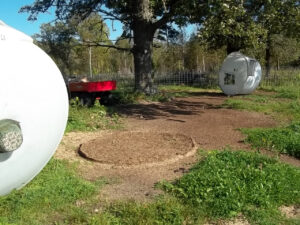
Soiled bedding was moved off-site to mulch young apple trees.By the end of the first summer, we had used most of our sawdust budget, so we reduced the sawdust to one inch.
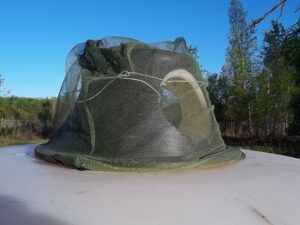
A head-net was placed over the top vent. The sheep lured the flies into huts. Hundreds of flies were trapped under the fly nets.
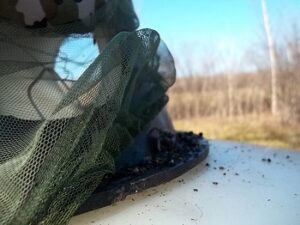
Game cams were set up in the paddocks to determine if sheep grazed during the day during the peak deer and horse fly season. We used 2 8G SD cards.
A hoop house was built with three 16-foot cattle panels arched over a 6 X 6 timber frame 6 X 12 Foot, and covered with a used billboard tarp. The interior side of the tarp is black , and the ends of the hoop house are covered in screen. When the sheep walk through the hoop house, biting flies got trapped against the screens and caught using fly tape – sticky side toward the screen.
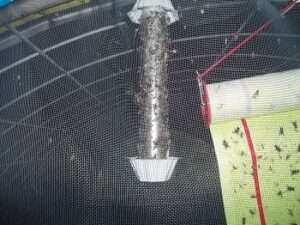
A NZI trap from Rincon-Vitova Insectaries was purchased for trapping horse, deer and stable flies. To set up the trap, we needed to provide 3-T-posts, three tension poles and a bendable piece of PVC pipe ½’ diameter to hang the jar. The top of the trap funnels flies into the peak where they enter a jar (not provided.) The jar needed to be suspended above the trap. I used a 60cc syringe tube with the tip cut off inside the jar, to keep the flies from getting out. The flies tend to fly upward and would not fly down the tube to escape.
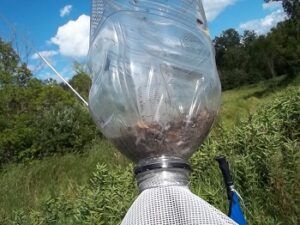
Aquatic biting flies are impossible to control by normal measures. They are not attracted by fly-bait, and are not affected by chemical repellents. They are attracted by the movement of the grazing flock and attack in large numbers. They drive livestock to seek shelter and reduce grazing activity.
PEOPLE
Tony Miller consulted on the project and presented the Power Point: Battling Buckthorn with Hogs and Sheep at the Upper Midwest Invasive Species Conference in Duluth, fall of 2015. That presentation resulted in the Woody Invasive Species Management – Field Tour on October 13, 2016. They had to limit the number to 25; 20 foresters and five landowners. The tour included farms that had fought buckthorn with chemical herbicide, mechanical removal and prescribed fire. After collaborating on this project the DNR Forester, Tony Miller wrote; “I am suggesting to St. Paul that we add a cost share practice for animal control of buckthorn.”
Thomas Gervais, Grazing Specialist with the NRCS was involved in the project. He provided a Prescribed Grazing Plan for this property and walked the property twice in 2015 to measure results. He was unable to visit the site in 2016 due to a job change but provided information and measurements from his 2015 visits. The full report is No. 19 in the results section below.
Scott Wagner helped with brush cutting and fencing, though his real job required 10 to 12 hour days and he was unable to provide as much help as originally planned.
RESULTS
The best way to kill buckthorn was to cut or break the buckthorn stem at about 30 inches above the ground and leave a portion of the bark intact. Then follow up by grazing off re-growth as needed each season. This was the most effective method, although limiting because it could only be used on smaller diameter stems. (It might be more effective to cut partway through larger stems, and leave the canopy intact.) By the second year most stems were dead.
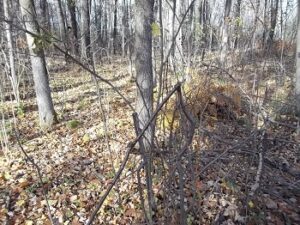
The second-best method was to cut the buckthorn stems at a height of 30 inches.
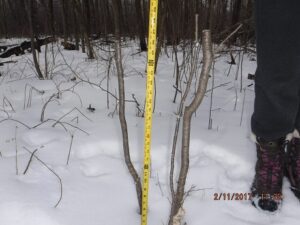
Simply cutting at a higher height didn't work without follow up grazing as needed to deplete the plants resources and effectively killed it. Conventional, cut and treat methods suggest cutting the stump low to the ground and slathering the stump with a mixture of herbicide and diesel and following up by re-treating stumps every year for up to five years until killed. This method was more labor intensive, uses expensive and toxic diesel/herbicide mix, and needs to be retreated for up to five years to be effective. It may be better to cut the stump at 30 inches and then treat with herbicide.
The least effective method we tried was to cut the stump short, about 6 inches. These stumps were resilient and put out new growth readily from the base.
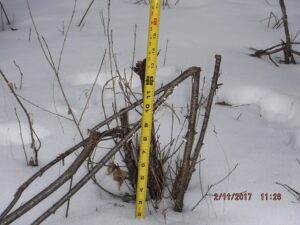
Though some of these died over time, many grew back the next year. Below, mushrooms show the death of this buckthorn that was cut tall, and re-grazed one full season to keep vegetation stripped clean.
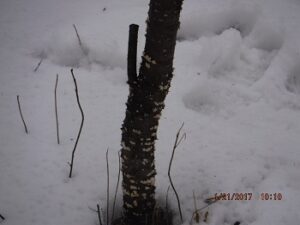
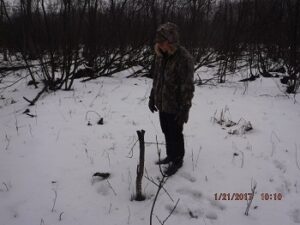
Prickly ash died, regardless of the height of the stump, after two seasons of targeted grazing.
Reed canary grass that was grazed by horses in early spring was most effective at keeping mats to a minimum for the rest of the season.

Sheep had the most impact on reed canary grass on riparian areas late in the fall when trampling and grazing reduced the mats. Many riparian areas were flooded in the spring when sheep were on paddocks. Sheep and horses are top down grazers. They take the first few inches off the top and return to graze lower on subsequent passes.
Horse flies, deer flies and stable flies could be effectively trapped using the NZI trap. The NZI trap was amazing. It was trapping horse flies before I got it all the way set up. I counted 273 horse flies, 93 deer flies, and hundreds of stable flies the first day in the NZI trap. The trap mimics the block shape of a grazing animal with daylight between the belly and the ground. The flies attack the underside of an animal, and the NZI trap effectively trapped them as they flew upward to attack. By the end of each season, cowbirds and fly catchers flew into the traps to catch the flies that hadn’t yet ascended into the jar. Though the actual fly counts were reduced by the birds, the counts were over 150 per day. Not bad for a fly that has been elusive to typical baits, repellents and pesticides. Horse flies and deer flies bite multiple times, so removing even one from the environment will improve animal and human comfort.
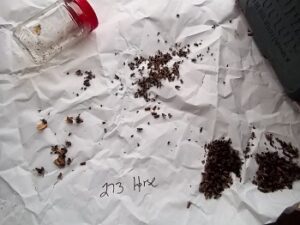
The Poly-domes effectively trapped flies using the sheep as lures. The Bite-Free Fly traps quickly got too full and needed replacing during peak fly season, June, July and August. (When sheep were removed for one week, no flies were caught in the poly-dome traps.)
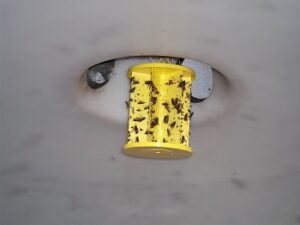
Horse flies and deer flies are not easily baited or trapped, nor are repellents effective, so control is difficult. Game cams showed increased daytime grazing activity during prime biting fly periods. Sheep tended to graze open areas and avoid brush/forest areas during peak deer fly season. The sheep and horses hung around the NZI traps during the day as if they provided relief from the flies.
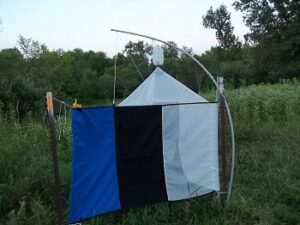
The block shape and special blue color attract flies.
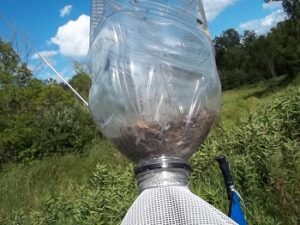
Flies funneled up into the catch bottle.

Stable flies could be effectively kept from growing by using two inches of sawdust in barns and removing soiled bedding often and taking it off site.
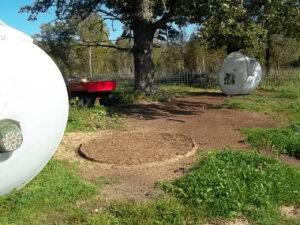
Soiled bedding made a great mulch in the apple orchard. However, we used up most of our allocated sawdust the first year, so reduced the amount used in the second year to one inch, which seemed to be effective. The cost of sawdust at $5 per bag was expensive, so after the sawdust ran out we found a more sustainable method was to move the Poly-domes onto fresh ground daily and use no bedding at all. Soiled areas were raked and removed off-site for composting.
- Using two inches of bedding for the horses was unsustainable. The horses seemed to come inside to use the stalls for a toilet. It worked better to remove all the bedding and use rubber stall mats to cushion the cement. The horses, no longer urinate or defecate in the barn. One theory is they won’t urinate/or defecate where it will splash onto their legs. It seems to be true.
- Game Cam pictures showed sheep grazed 24 hours a day and preferred sundown grazing to daylight grazing. Horse flies and deer flies do not fly at night. During sunny daytime, the sheep spent more time in the shelters to get away from biting flies. Many horse flies, deer flies and stable flies were lured into the traps at the top of the poly-domes. More flies flew into the head-net over the top of the dome and were trapped and died, probably from starvation and sun exposure. Other species of flies and insects were also caught, especially insects that feed on flies. As the summer progressed, birds began going into the poly-domes, presumably to catch insects trapped there. Feathers were found on the sticky traps.
- Buckthorn closest to barns and paddocks were grazed more frequently and died faster than plants farther away. So, moving sheep closer to targeted plants is most effective for killing buckthorn.
- Paddocks with milkweed patches were protected for Monarch butterfly habitat.
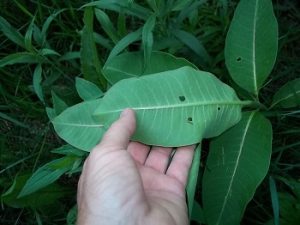
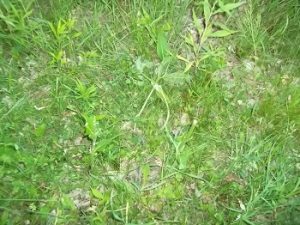
- Horses will not graze milkweed, but sheep will. We grazed horses in our milkweed paddocks and still produced many Monarch butterflies. Once the Monarch season was winding down, we let the sheep graze the milkweed paddocks.
- What worked best for fences – all were purchased from Premier 1:
The Semi-Permanent Electro-Fence 11/48/12 Premier 1- ($133.00 per 100 feet) was by far the easiest fence to work with. The posts are stronger and the upright “stays” helped keep the fence taut and was easier to roll-up when moving. The extra strength and stiffness of the web made it easy to fence meandering lines for any shaped paddock without the additional support of T-posts. It is light enough for one person to pick up and move or could be set up for the entire grazing season.
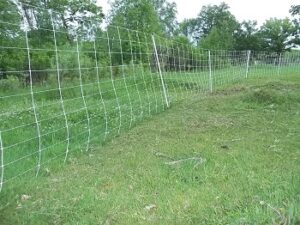
Short grass on right side of fence is resting. Grass on other side is also resting, until it reaches 6-8 inches of growth.
The Hog-Quik fence (6/30/12 - 100 foot rolls @82.00, purchased for grant FNC10-838.) The posts are strong and the fence is short enough to step over when walking pastures. The strength of the posts and stiffness of the web allows for set-up in any shape or meandering line as needed. It is easy to roll-up and move, even in brushy conditions.
We also used 400 feet of Electro-net sheep fence 9/35/12. (82 feet for $93.00) This fence was not as effective to use in this situation. The posts are weak and flimsy and the webbing is floppy and sagged. Each section needed support from T-posts to keep it from drooping. That required more labor to set up and move and was only useful for a straight-line fence. Because it was so floppy it was difficult to roll-up neatly.
The horses were fenced and cross-fenced with a single ribbon and wire and 4-D-cell batteries in the Zareba fencers.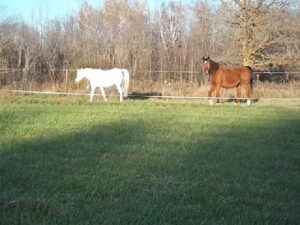
Predator Control: Most predators do not target sheep as a natural feed source. Effective predator control involves not making sheep an easy target. Safe solid paddocks, electro-web fences, and Nite-Guard solar lights were effective at keeping predators away from sheep. We had no predation problems, though game cam pictures showed the electro-web fences were effectively keeping out coyotes, stray dogs and bears.
After touring two farms using mechanical, chemical and fire methods, the hogs and sheep were much more effective at killing buckthorn, requiring less labor and no herbicide cost.
Sheep can effectively be used in remote areas by providing safe paddocks, shelters, fly traps, electro-web fence and water tanks. It may be useful for impacting remote sites on public land where chemical herbicides could leak into sensitive wetlands.
Thomas Gervais, Grazing Specialist NRCS and collaborator on this project provided the following report:
“As part of the project, we evaluated the impacts of grazing management on invasive or undesirable plant species, including common buckthorn and reed canary grass.
Note: two growing seasons was not enough time to evaluate long term effects of grazing management. Visually, it appeared that the management that was applied was adequate to have impact on the targeted species, however more monitoring is needed to determine whether the desired effects were achieved.
Initial planning efforts resulted in targeting relatively high stock densities (as opposed to the prior grazing management on the site) and short grazing periods by using temporary electro-netting and a solar powered fence charger. Prior stock density was in the range of 250# of animal live-weight per acre (continuous grazing with horses) Planned stocking density was in the range of 12,000#/acre (17 ewes and lambs on ¼ acre). The higher stock density would remove the ability of the livestock to select a diet of only “preferred” species and promote impact of all species, including those that are typically unpalatable, as in the case of reed canary grass. Visual inspection showed that the planned stock densities improved the grazing distribution and utilization of undesirable species. Stock densities varied throughout the grazing seasons but were targeted to be in the planned range.
In November of 2015, vegetative measurements were taken along a transect to document effects of high stock density grazing on desirable and undesirable species. Clipping was done within exclusion cages to determine the level of utilization as a result of the applied management. Utilization was approximately 66% of the total standing biomass. Plant height and species density measurements taken along the transect showed that nearly all species marked within the grazing area were utilized to some degree by the livestock, as a result of the increased stocking density. Utilizing the temporary netting and planned grazing periods resulted in appropriate plant rest after grazing events.
In 2015 grazing was limited within the targeted reed canary grass areas due to high water levels.”
PROJECT IMPACTS
Economic: It is expensive to treat buckthorn, both for herbicide, labor and equipment. Our projects showed how to get more effective results with no cost for herbicide, minimal cost for equipment, and a minimal amount of labor per plant. The fence is a big investment, but is re-useable and is still in good condition after 7 years of use. The average cost for mechanical removal of buckthorn is $1000 per acre. Our cost was far less on 30 acres. The biggest impact from this project is that the Minnesota DNR is considering cost sharing for animal control in the next fiscal year. The annual meeting is in March 2017 and a decision will be finalized then. This is a direct result of this research as it was introduced by Tony Miller at the Invasive Species Conference in Duluth in 2015 using my Power Point.
The Invasive Species Field Day of 2016 had to limit the attendance, but allowed 18 foresters, and 7 landowners and invasive species specialists to attend. DNR participants used the field day for required on-going training.
Foresters can provide landowners with a no-chemical option of removing invasive species, that costs less and reduces labor as well as years of follow-up treatment.
Using the NZI trap in the pastures was effective at eliminating the need for fly repellents for our horses. Animal comfort has been improved by reducing biting flies with traps.

We normally use fly repellent on our two horses twice a day at a cost of over $300 dollars each season. In 2015 and 2016, we did not need any fly repellent.

Livestock comfort was improved during fly season as evidenced by Game Cam photos which showed sheep grazing during day-time hours.
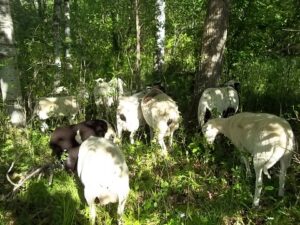
Soiled livestock bedding was used for mulch in the apple orchard.

As a comparison to alternative methods of buckthorn removal, our method uses no toxic herbicide, less physical labor and is faster at killing buckthorn than other methods. This method could be used on public lands to keep pristine land free of herbicides while targeting buckthorn and reed canary grass.
Intensive rotational grazing has improved the quality of forage for our lambs and horses, provided weed control without the use of herbicide, and reduced erosion by retaining more stem height and plant vigor.
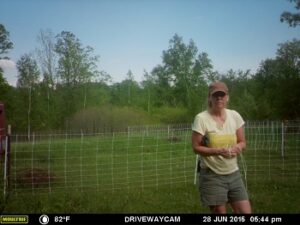 Daily pasture walks helped determine which paddocks were ready for grazing.
Daily pasture walks helped determine which paddocks were ready for grazing.
We have eliminated the need for hay supplementation during the hot dry summer months, and extended the grazing season to over eight months, which also reduced hay needs during the winter. Rather than roll up round bales of hay, we cut haying costs by grazing hay ground during November, December, and now in February, as snow melts off the field. Our horses and sheep, did not need grain during the eight-month grazing season because of better forage quality.
While horses need worming in the fall for Bot fly control, and sheep need worming in the fall for Liver Flukes (as indicated by our butcher,) these parasites do not shed eggs into the feces so are hard to detect. For other parasites, the fecal samples showed no significant presence of parasites for either species. If not for the bot and Liver Fluke issues, we might have avoided worming altogether. Because of using fecal samples, our worming was necessary only one time per year, rather than multiple worming in past years without that data.
Environmental: Most buckthorn is killed with large amounts of herbicide. Herbicide applied on cut stems, is mixed with diesel fuel. Wildlife, humans and native plants can encounter the greasy toxic mess. Many riparian forests are sloped down to the river. In heavy rain events the chance of herbicide reaching the river is high. Buckthorn not killed from one application of herbicide needs to be re-treated for up to five years. Buckthorn creates a mono-culture, and reduces habitat for wildlife. Our project provides an effective method of killing buckthorn without the use of herbicide. We recommend leaving the stumps taller, and grazing to keep vegetation off for one year.

Mushrooms cover dead stems.
Reed Canary grass has invaded riparian areas by out-competing native riparian species and creating a monoculture that threatens wetland ecosystems.

Wildlife rely on native species plants for a food source and habitat. Unlike native species, dense stands of reed canary grass have little value for wildlife. Areas that have existed as reed canary grass mono-cultures for extended periods have seed banks that are devoid of native species. Targeted grazing with horses in the spring and sheep in the fall reduced reed canary grass stands, kept the grass from putting on seed heads and allowed native species to compete. Native riparian plants have deeper root systems than reed canary grass and will reduce siltation and erosion of river banks.
At Bear Street Ranch, Buckthorn has been completely removed from the middle story of targeted forest acres, allowing native species increased light and space. As native species thrive, wildlife habitat will be improved and provide better natural feed and nesting areas.
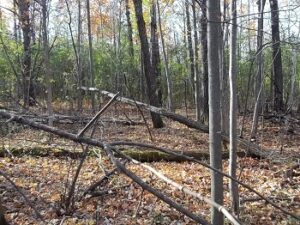
Picture shows buckthorn removed from the under-story, the green in the background is the buckthorn on our neighbor's property.
Reduced use of wormers on our farm will reduce the incidence of wormer resistant parasites, resulting in more effective control of internal parasites in the future
Social: The Groundhouse River flows into the Snake River, the St. Croix River and into the Mississippi river watershed. The Mississippi River is the source of water for over 50 major US cities. By investigating new ways to target invasive species, and farming methods like intensive grazing, we can reduce erosion, siltation, and run-off of toxic herbicides. Improving water quality at the top of the watershed could impact the health of human users of Mississippi water across the central US.
Outdoor recreation areas across central Minnesota could benefit from the effectiveness of the NZI trap. Many outdoor enthusiasts are driven indoors during deer fly and horse fly seasons in mid-summer. The NZI trap removed as many as 300 flies each day. Each fly can bite multiple times and trapping can improve outdoor comfort in the area around the trap. NZI traps could improve outdoor comfort, if placed around public pools and beaches.

OUTREACH
I have set up a web-site at www.bearstreetranchllc.wordpress.com. It includes pages on removing buckthorn without chemicals, and is still being upgraded.
We have provided a Power Point presentation for use in outreach. Additional information is being summarized from this project.
In 2016, Susan Burks, MN-DNR Invasive Species Program Coordinator, set up an Invasive Species Field Day as training for DNR foresters. Our project was highlighted as an effective alternative to conventional methods of buckthorn removal. We toured farms using conventional cut and treat (with herbicide,) mow and spray methods, and prescribed burning. It demonstrated a good comparison of these methods, to our cut and graze method. Because of this project, the DNR is looking to provide funding to people who use animals to remove buckthorn.
Below is a summary by Susan Burks, the Invasive Species Program Coordinator for the Minnesota DNR for the Invasive Species Field Day hosted at Bear Street Ranch, LLC.
- Hair sheep work well to defoliate/starve plants. They are browsers, not grazers, easy to maintain with no shearing or dehorning needed. Worming necessary but effective treating half the herd. Need to bend/break taller plant tops down so sheep can reach (retaining the canopy also keeps plant from putting on a new top growth). Used roughly 1 sheep & 2 lambs per acre.
- Hogs work well too. Can uproot small plants and tear through brush. Have to move every 2-3 wks, but electric pig fencing is easy to move. Don’t seem to be getting re-sprouts or buckthorn seedlings back in. May have to reseed to reestablish native forbs and prevent new invasions by other invasive spp. If hot outside, have to entice hogs out of shelter. Placed old fruit and ice cream gathered from local restaurants and markets in area most needing the browse. Used 2-6 hogs per 4 acres.
- Biggest problem is horse and deer flies. NZI fly trap works well. Animals periodically stand next to it rid themselves of bugs before resuming their browsing. Fly trap in top of poly shelter also worked well. Browsing intensity varied though by distance to shelter and fly traps.
Below is a list of participants:
Cheryl Culbreth
Landscape Restoration
612-590-9395
Tony Hoff
Outdoor Services
612-328-3860
George Swanson
Future Forests
320-630-6644
Wayne Martin
UMN Extension, NCR-SARE State Co-coordinator
612-625-6224
Tony Hoff, Buckthorn removal
Cheryl C, DNR Forester
Dave Vander Vegt, Landowner;
Hafvenstein, Stephen (DNR) Forester
Mouelle, Jean J (DNR);
Wilder, Jeff (DNR);
Gajewski, Robert (DNR);
Miller, Tony L (DNR)
Schuller, Dave (DNR);
Arends, Andrew J (DNR);
Leitinger, Brian (DNR);
Baysal, Cassandra (DNR);
Reisz, Christine (DNR);
Wysocki, Daren C (DNR);
James Burks- Landowner
Kristi Silber; DNR
Mark Miller DNR
Parisio, Michael (DNR)
Beyer, Tim (DNR);
Mitch Lundeen- Landowner
On October 6th, I spoke at a landowners’ meeting for Janet Smude, Aitkin County SWCD. It was attended by twenty-five landowners from the Onamia area and several NRCS professionals. I gave a power point presentation on removing buckhorn without herbicide summarizing the results of this grant research.
Janet Smude
Aitkin County SWCD
(218) 927-6565 ext 110
GRIT magazine published an article about the project “Pastured Pigs Clear Out Invasive Buckthorn,” in June 2015
In 2016, the Minnesota Landowner Handbook, Amanda M. Kueper, MS, featured our buckthorn project
PROGRAM EVALUATION
The Call for Proposals was very effective at providing information to write a successful proposal, with helpful questions to improve the results and provide greater impact for other farmers and ranchers.
One suggestion is to offer access to a “Proposal Reader” from past grant reviewers with three years of experience to provide insight to grant writers for project improvements.
Soil tests will be taken in 3 areas of the pasture and analyzed for evaluation, spring and fall 2015 and 2016. Three test sites 16 X 16 feet will be fenced off for comparison to grazed areas. Buckthorn brush will be cut in early spring and piled for wildlife habitat or burned.
Pasture will be fenced with 4’ electro-web portable fences. Each of five, 8 foot wide Poly-dome calf huts will provide 50 square feet of space for two ewes with lambs. A Nzi fly trap will be placed in an open, sunny location to trap Tabanid aquatic flies. Five Bite-Free Traps and fly tape will be placed in paddocks and barns to control filth flies. Dry sawdust bedding will reduce fly numbers by limiting places to lay eggs and raise larvae. Poly-dome Calf huts will have one inch of dry wood shavings. Wet soiled bedding will be moved off site and composted. Twice monthly fly count wills determine success of traps. Two horses will graze with sheep to help deter predators and control species-specific parasites. Trail cams will used to determine whether predators are getting into the Electro-web fences and how often sheep graze during the day. Nite Guard Solar predator lights will be placed in pastures for night time predator control. A deep cycle marine battery with a solar charger will keep the fences electrified. Cattle panels will be used to establish secure paddocks inside electro-web fences. Paddocks will be used to contain sheep when temporary grazing fences are being moved. Pastures will be walked daily to check forage condition. Sheep will be moved to new pastures as forage height gets under four inches. Sheep, fences, polydomes and water tanks will be moved to new pastures approximately once a week.
Two site visits by Grazing Specialist Tom Gervais will document the results of intensive rotational grazing on reed canary grass, weed suppression, and improvement of pasture condition. Two site visits by Tony Miller will document the control of Buckthorn for the Woodland Stewardship Plan.